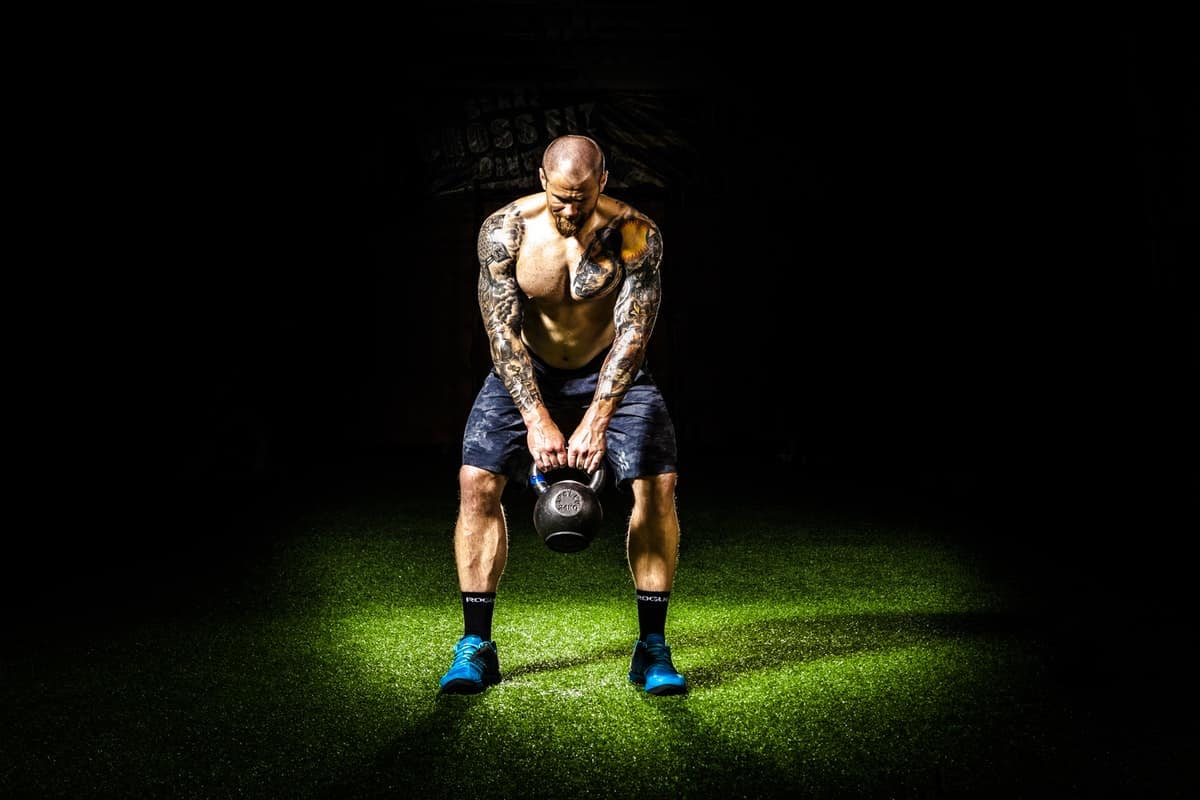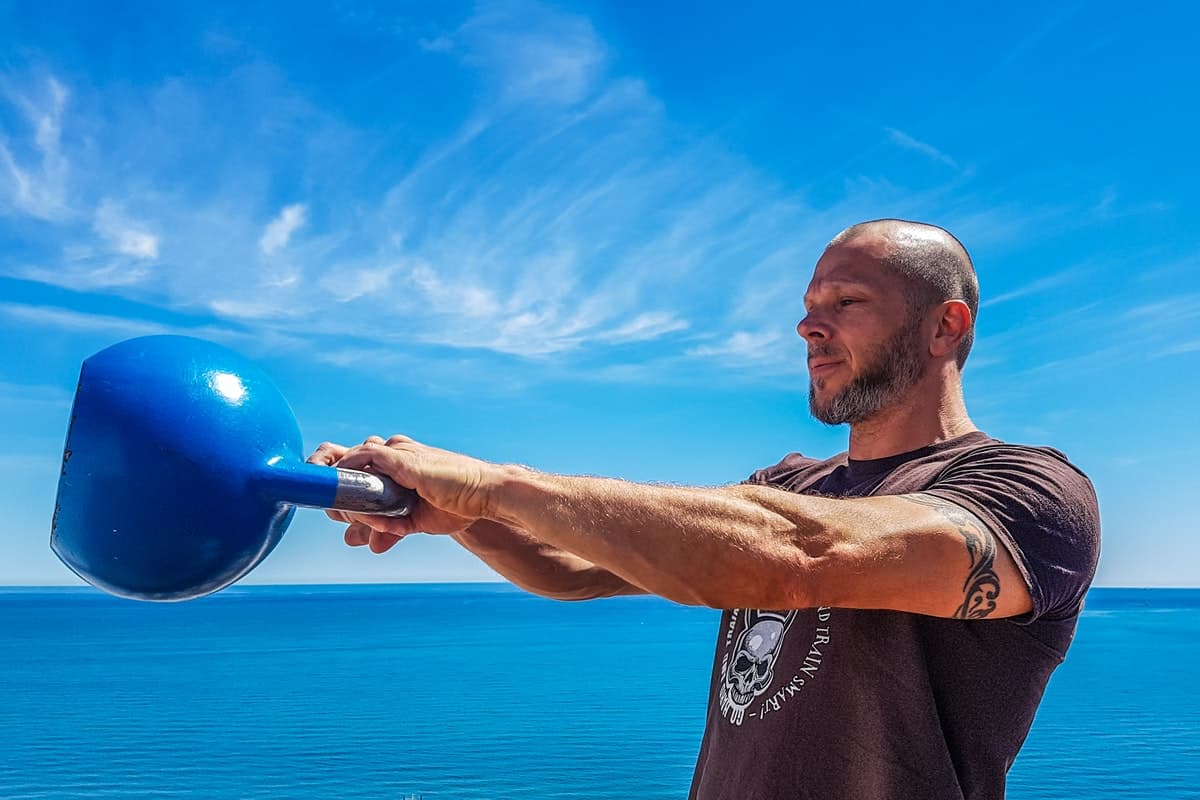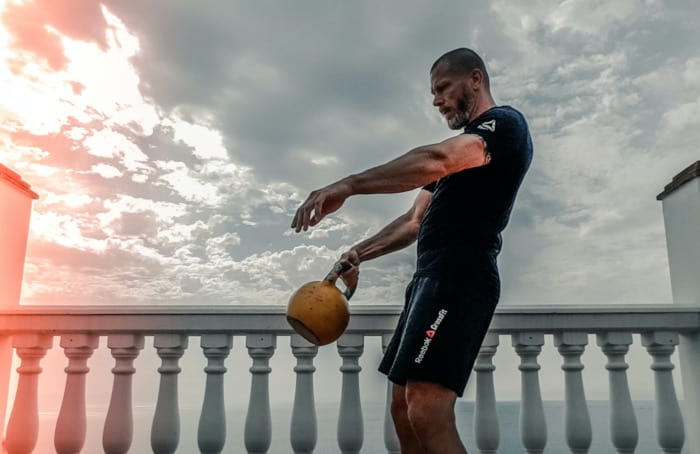In this article, we will analyze the Kettlebell Swing or swinging with Russian weights.
In recent years, Strength & Conditioning professionals have been provided with a wide variety of athletic preparation tools and exercise modes.
Among these tools is the Kettlebell (KB) or Russian Weight, an implement widely used in Russia before its recent popularization in the United States (3).
Currently, kettlebell exercises are used in various recreational fitness programs and in some collegiate and professional strength and conditioning programs (3).
The off-centered center of gravity and unique construction of the kettlebell provide the user with a suitable tool for full-body ballistic exercise (3).
In relation to this, the objective of this article is to review and synthesize the available evidence about the Kettlebell Swing.
What is the kettlebell swing?
The Kettlebell Swing is an exercise performed with kettlebells and consists of swinging these weights.
To perform the swings you must stand, opening your legs a little wider than shoulder-width apart and with your toes pointing slightly outward. Place the weight between your feet.
The exercise begins by bending the knees to grab the weight with both hands. Do not place them too close together; it is better to have them a little apart to better control the weight of the kettlebell.
Kettlebell swing: a popular exercise
Strength & Conditioning professionals have access to a wide range of training methods and equipment (7).
One of these training implements is the Kettlebell or Russian Weight, which has been a very popular training tool in Russia for many years.
In fact, the Russian word for kettlebell, “Girya“, first appeared in a Russian dictionary in 1704 (7).
Currently, kettlebell training has become a staple of strength and endurance training programs (7).
Kettlebell training has become a very effective and efficient tool for Sports Functional Reeducation and Sports Performance (1).
The Kettlebell Swing is re-emerging as an alternative methodology to train both the muscular and cardiovascular systems (10).
During this exercise, the hip extension creates momentum that propagates through the trunk and arms to the kettlebell, which is propelled forward and upward in a swinging motion (1).
Specifically, there are two main styles of Kettlebell Swing (1):
- Russian Kettlebell Swing: the upward movement ends when the kettlebell is in front of the head.
- American Kettlebell Swing: the upward movement ends when the kettlebell is directly above the head.
- La Pesa Rusa o Kettlebell Ajustable de 2,5 a 18 kg. está diseñada para mantenerse de pie sobre cualquier superficie sin que esta sea dañada, ideal para guardarla en casa y muy adecuada para un amplio rango de edad desde principiante a experto.
Mechanics of the kettlebell swing
The Kettlebell Swing is a dynamic-ballistic repetitive movement, which includes concentric and eccentric muscle contractions that emphasize the cyclical and explosive extension of the hip in the horizontal plane (8,15).
As a consequence of this muscle dynamic, there is a great activation of muscle mass in the posterior chain, trunk, and lower limb musculature (13).
On the other hand, this movement is mainly created by the hip extensors and is transferred through the center to the limbs and kettlebells (1).
The core muscles (read article here) play a key role in stabilizing the trunk, allowing effective force transfer from the hip to the arms holding the kettlebell (1).
At the same time, neutral spinal alignment is key through the activation of the posterior chain muscles (glutes, hamstrings, and back extensors) (3).
Finally, it is necessary to comment on the general technical execution of the Russian Kettlebell Swing: the movement begins with the person standing in front of the kettlebell.
Next, from a quadruped position, where the person’s body weight must be over the kettlebell, the athlete will shift the body weight towards the heels, maintaining a neutral spine, to initiate the backward pull.
After this, the hips move backward in a “Hip-Hinging” motion where active stretching of the hamstrings occurs while maintaining correct alignment between the back of the head and the sacral vertebrae.
At the same time, “Packing” of the shoulders (keeping the scapular waist neutral) should occur during the backward-downward swing phase.
Then, the movement is forcefully reversed, aiming to project the hip and kettlebell forward, continuing with the swing phases continuously and stably (14).
La siguiente certificación proporciona el entendimiento de todo aquello que rodea al gasto calórico y las necesidades energéticas de los entrenamientos del Crossfit.
How much do you know about crossfit?
Below we leave you a small test about crossfit to test your knowledge. It will only take you 1 minute, it is very fun and educational, and you will even get a gift at the end.
What does science say about the kettlebell swing?
Next, we will see what scientific evidence says about the Kettlebell Swing.
Muscle activation
- The One-Armed KB Swing presents high neuromuscular activity for the contralateral side of the upper erector spinae and the ipsilateral side of the rectus abdominis (1).
- The One-Armed American KB Swing induced the greatest activation of the contralateral erector spinae muscle, however, the Two-Armed KB Swing caused the greatest activation of the rectus abdominis (2).
- The main finding was that during all contraction modes and swings, the medial part of the hamstrings had significantly greater myoelectric activity than the biceps femoris. Additionally, the Hip Hinge showed a significantly higher level of combined myoelectric activity during all repetitions compared to the Squat Swing and Double Knee Extension (5).
- The following activation demands were observed: erector spinae (KB Swing > KB Snatch), contralateral external oblique (KB Snatch and Clean > KB Swing), and vastus lateralis (KB Swing > KB Clean) (16).
- Therapeutic movements targeting the hamstrings can be divided into knee or hip dominant exercises. Specifically, the Kettlebell Swing and the Romanian Deadlift are hip-dominant exercises, specifically activating the Semitendinosus over the Biceps Femoris (22).
View this post on Instagram





